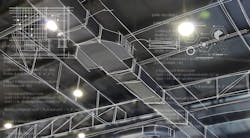5 ways to reduce the carbon impact of smart building technologies
By Betsy Conroy
In the smart building industry, eco-friendly sustainable building materials are a key part of reducing emissions and achieving green building certification. LEED, WELL, BREEAM, Green Star, and other assessment programs all address materials and resources to reduce hazardous ingredients and minimize the impacts associated with the extraction, processing, transport, and disposal of building materials. LEED, for example, provides points for the use of sustainable building materials like no- or low-carbon brick, green concrete, recycled plastics and metals, wood fiber-based insulation, gypsum board, reclaimed wood, and bamboo.
While smart building technologies are vital to improving building efficiency, the actual technology products deployed throughout a smart building are mostly made up of fossil fuel derivatives and mined from non-renewable resources—from the IoT devices to the networks that connect them. That inherently makes it unfeasible for most of these products to be considered low-carbon construction materials. Even so, there are ways to reduce their impact.
“In the U.S., buildings as a whole are responsible for about 40% of greenhouse gas emissions. Building technology falls under building materials and construction, which represents 11%,” says Ronna Davis, who manages strategy and technology for CommScope’s enterprise building and campus business. “But how the industry designs, delivers, architects, and manages those products can have a significant impact on lowering emissions.”
Davis outlines five measures that minimize the carbon impact of the technologies that make a building smart.
1. Bring transparency to a new level
According to Davis, standard material safety data sheets are required to measure to 10,000 ppm for harmful chemicals, while green building programs like LEED require 1,000 ppm. “While aspirational, the goals is to eventually get to 100 parts per million, which will give us the detail we need for more accurate measurement of environmental impact. But that’s not easy when it comes to technology products that have a deep supply chain, and it will take time to get suppliers and their suppliers to comply,” says Davis. “But it’s happening—just like some food makers provided detailed ingredients before it was mandated by the FDA, we have movers that are getting this transparency underway with their technology products.”
In addition to EPD and MIR, those selecting smart building technology can look to health product declarations (HPD) that provide information on a product’s impact on human health. They can also require supplier sustainability reporting and ensure that product labels indicate that they are free from Red List materials. Developed by the International Living Future Institute, the Red List represents worst-in-class materials, chemicals, and elements known to pose serious risks to human health and the greater ecosystem that are prevalent in the building products industry.
2. Ditch the cradle-to-grave mentality
Measuring the impact of a product can be done by assessing its lifecycle from cradle to gate, which includes everything it takes to manufacture and deliver a product, or cradle to grave, which includes the use and disposal phase. Cradle to cradle is a newer concept based on the theory that the end of a product’s use cycle is followed by the beginning of another. “We tend to look at cradle to grave, but cradle to cradle that takes it one step further is where we want to get to,” says Davis. “We need to remember that matter can’t be created or destroyed; it can only change form. If we’re going to extract minerals and use resources to produce a product, we need to think about where those materials are going to be not just in five years when I’m done with the product, but infinitely.”
3. Leverage the latest and greatest tools
“The EC3 tool is great because it’s free and makes it easy to benchmark, assess, and reduce embodied carbon. We can use it to help us understand how product selection and architecture impacts embodied carbon,” she says. “We’re also going to get really good at digital twins, and we can combine that with embodied carbon calculations to discover in real time how technologies can reduce impact.”
4. Architect for reduction
“How we architect and design the networks and technologies that support a smart building can help reduce embodied carbon,” she says. “There are many solutions that support sustainability, but if a solution is proprietary and doesn’t share the same infrastructure, it adds material and may not be reused. We need to continue standardizing on well-planned, open architecture that can connect and power more systems and devices. And we can use tools like the EC3 calculator and digital twins to understand the impact of segmented technologies and model buildings that use open protocols against those that don’t.”
5. Maximize and demonstrate offsets
“It’s unlikely that we’ll get to carbon neutral or carbon negative organically with technology, so we need to look to maximize its environmental benefits and carbon-offsetting attributes,” says Davis. “We have been so focused on technology and innovation for decades, and what we’ve accomplished is amazing—we laid the groundwork for technology that enables sustainability and will save the world. But now it’s time to rein it in and make sure we’re being responsible. We can do better by coming together and measuring more discretely to demonstrate the positive impact of technology to stakeholders and the industry as a whole.”
Betsy Conroy is a freelance writer, editor, and content consultant specializing in business-to-business media and commerce.





